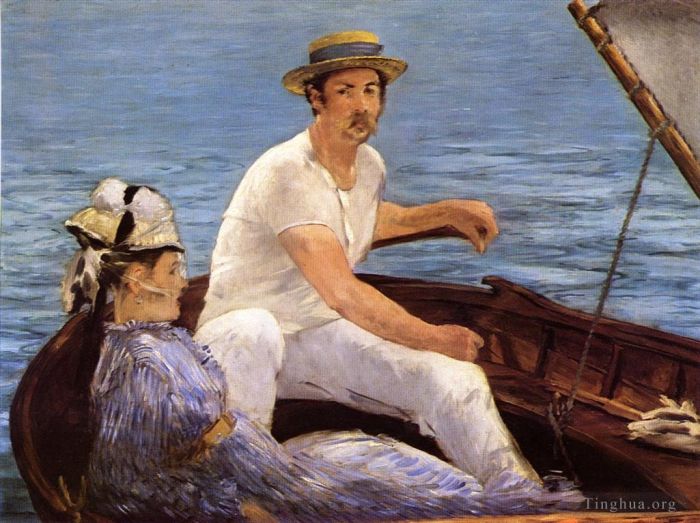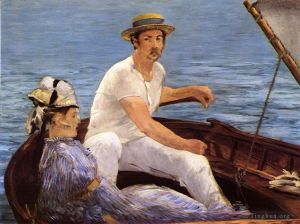Boating
Edouard Manet
- Price: Price on Request
- Art Type: Oil Painting
- Size:
- English Comments: 0
- International Comments: 0
- Creating Date:
- Introduction and Works of Edouard Manet >>
Keywords:
Boating
Work Overview
- Boating
Edouard Manet
Date: 1874; Paris, France *
Style: Impressionism
Genre: genre painting
Medium: Oil on canvas
Dimensions: 38 1/4 x 51 1/4 in. (97.2 x 130.2 cm
Manet summered at Gennevilliers in 1874, often spending time with Monet and Renoir across the Seine at Argenteuil, where Boating was painted. Beyond adopting the lighter touch and palette of his younger Impressionist colleagues, Manet exploits the broad planes of color and strong diagonals of Japanese prints to give inimitable form to this scene of outdoor leisure. Rodolphe Leenhoff, the artist’s brother-in-law, is thought to have posed for the sailor but the identity of the woman is uncertain.
Shown in the Salon of 1879, Boating was deemed "the last word in painting" by Mary Cassatt, who recommended the acquisition to the New York collectors Louisine and H.O. Havemeyer.
Manet summered at Gennevilliers in 1874, often spending time with Monet and Renoir across the Seine at Argenteuil, where Boating was painted. Beyond adopting the lighter touch and palette of his younger Impressionist colleagues, Manet exploits the broad planes of color and strong diagonals of Japanese prints to give inimitable form to this scene of outdoor leisure. Rodolphe Leenhoff, the artist’s brother-in-law, is thought to have posed for the sailor but the identity of the woman is uncertain.
Shown in the Salon of 1879, Boating was deemed "the last word in painting" by Mary Cassatt, who recommended the acquisition to the New York collectors Louisine and H.O. Havemeyer.
Boating was painted in the summer of 1874 when Manet was at the family home at Gennevilliers on the Seine, opposite Argenteuil. At this time he was frequently joined by Claude Monet, who had been living in Argenteuil for some time, and occasionally by Renoir. Manet painted Monet and his wife and it was at this period that he came closest to adopting the impressionist idiom of working in the open air, using short rapid brushstrokes and adopting a much higher key than in his earlier work. This painting however is in many ways still tied to Manet's traditional practice. It is much larger than the portable canvases Monet and Renoir were using at this time and this would suggest it was done in the studio. Similarly, there is none of the apparent spontaneity that characterized impressionist works of this period, particularly in the rather contrived nature of the composition, which owes much to careful planning and is closest in spirit to Japanese prints.
This picture was painted during the summer of 1874, when Manet was working with Monet and Renoir at Argenteuil, a village on the Seine northwest of Paris. The influence of the two young Impressionist painters on Manet is evident in the subject matter - a celebration of the everyday pleasures of the middle class - and in the fact that Manet's dark, Spanish palette has given way here to high-keyed hues. The flattened composition, in which the high viewpoint causes the water's surface to rise up as a backdrop, is cut off at the edges of the canvas, reflecting Manet's interest, shared with the Impressionists, in Japanese prints.
The Argenteuil (of vertical format) and the Boating (of horizontal format) are two open air genre portraits - rather than landscapes - which Manet painted in August 1874 at Argenteuil. The vertical-format painting is structurally the tighter thanks to its linear components, and is also the richest in motifs and forms. The sketchy horizontal-format picture uses large spaces of glowing colour. We do not know who the women in these paintings are; the man was either Manet's brother-in-law, the Dutch painter Rodolphe Leenhoff, or Baron Barbier.
- Copyright Statement:
All the reproduction of any forms about this work unauthorized by Singing Palette including images, texts and so on will be deemed to be violating the Copyright Laws.
To cite this webpage, please link back here.
- >> English Comments
- >> Chinese Comments
- >> French Comments
- >> German Comments
- >>Report
- Basket of Fruits
- The monk at prayer
- At Father Lathuille
- The Luncheon on the Grass (The Bath)
- The Grand Canal Venice
- Portrait of Emile Zola
- Portrait of Lina Campineanu
- Young Man in the Costume of a Majo
- The Bullfight
- Bench in autumn
- Victorine Meurent in the costume of an Espada
- Portrait of Zacharie Astruc
- Carnations and clematis in a crystal vase
- A boy with a pitcher
- Madame Brunet
- A matador
- On the Beach at Boulogne
- Reading Mme Manet and Leon
- Peaches
- The Kearsarge at Boulogne (Fishing boat coming in before the wind)
- Interior at Arcachon
- The ragpicker
- Woman in furs
- The model
- Madame Manet on a Blue Sofa
- Monet in his Studio Boat (Claude Monet Painting on His Boat-Studio in Argenteuil)
- Guitar and Hat
- The House at Rueil
- The Suicide
- Branch of White Peonies and Pruning Shears
- Jetty at Boulogne
- Portrait of Faure as Hamlet
- The Railway (Gare Saint-Lazare)
- Marguerite de Conflans Wearing Hood
- Theodore Duret
- Steamboat Leaving Boulogne
- Portrait of Gilbert Marcellin Desboutin
- Still Life Fruits on a Table
- The garden around Manet house
- Corner of a Café-Concert
- Boy with Dog
- Portrait of Mademoiselle Claus
- Young woman with a pink shoe
- Le Bon Bock A Good Glass of Beer
- Boy Blowing Bubbles
- Berthe Morisot with a Bouquet of Violets
- Portrait of Monsieur Brun
- Portrait of Emilie Ambre in the role of Carmen
- Effect of Snow at Petit Montrouge
- Vase of White Lilacs and Roses
- View of the 1867 Exposition Universelle
- Study of trees
- Moss Roses in a Vase
- Angelina
- Roses in a Champagne Glass
- Spring Study of Jeanne Demarsy
- The barque of Dante Copy after Delacroix
- The Street Singer
- Singer at a Cafe Concert
- Baudelaires Mistress Reclining Study of Jeanne Duval
- The Lemon
- Repose Study of
- A Game of Croquet
- Polichinelle
- Masked Ball at the Opera
- Bundle of Asparagus
- The Departure Of The Folkestone Boat
- The spanish ballet
- Argenteuil
- Plum
- At the Cafe
- Bench
- Gypsy with a Cigarette
- Rose and tulip
- Vase of Peonies on a Small Pedestal
- The Dead Christ with Angels
- Stephane Mallarme
- Nana
- Music in the Tuileries
- Christ with Angels
- Madame Manet in conservatory
- Swallows
- The Luncheon in the Studio
- Flowers in a Crystal Vase
- Madame Manet at the Piano
- Rochefort Escape
- The philosopher
- Still Life with Brioche
- Lola de Valence
- Bull fighting scene
- Portrait of Eva Gonzales
- Bouquet of flowers
- Eva Gonzales
- The Spanish Singer The Guitar Player
- Portrait of Mademoiselle Isabelle Lemonnier
- The Blonde with Bare Breasts
- The Waitress
- Woman with umbrella
- Young woman in the garden
- A Corner of the Garden in Rueil
- Madame Manet at Bellevue
- The Rest portrait of
- Woman Reading
- Bathers on the Seine
- Two Roses on a Tablecloth
- Le Chemin De Fer The Railroad
- The burial
- Execution of the Emperor Maximilian
- Embarkation after Folkestone
- Portrait of Henry Bernstein as a Child
- Head of a Dog
- The head of Christ
- Mother in the Garden at Bellevue
- Autumn Study of Mery Laurent
- The Races in the Bois de Boulogne
- Still life with melon and peaches
- Woman Before a Mirror
- Jesus Mocked by the Soldiers
- Flowers In A Crystal Vase flower Impressionism Edouard Manet
- The Port of Bordeaux
- A brioche
- Rue Mosnier decorated with Flags
- The Banks of the Seine at Argenteuil
- Lilac in a glass
- Woman Pouring Water Study of Suzanne Leenhoff
- The Monet family in their garden at Argenteuil
- View of Holland
- Portrait of Antonin Proust Realism Impressionism Edouard Manet
- Boating
- A King Charles Spanie
- Peonies in a vase
- The Horsewoman
- M and Mme Auguste Manet
- The conservatory
- Woman in a Tub
- A young man peeling a pear
- The Jetty at Boulogne
- Interior of a Cafe
- The ham
- On The Beach
- Pertuiset Lion Hunter
- The grand canal of Venice
- Oysters
- The Execution of the Emperor Maximilian of Mexico
- In the garden
- Portrait of Antonin Proust
- Victorine Meurent
- Young woman with a book
- Tarring the Boat
- Young woman in a round hat
- The Races at Longchamp
- The Milliner
- At the races
- The absinthe drinker
- Olympia
- Seascape at Berck Fishing Boats and Fishermen
- The old musician
- The Balcony
- Fishing
- Madame Auguste Manet
- The Boy with Cherries
- The Fifer
- Women at the Races
- Portrait of Suzanne Manet
- Surprised Nymph
- Portrait of Monsieur Tillet
- Almonds currants and peaches
- The stroll
- Young Woman in Oriental Garb
- Battle of Kearsage and Alabama
- The road menders Rue de Berne
- Woman with a Parrot
- Boy with a sword
- Eel and Red Mullet
- Woman with Fans (The Lady with Fans or Portrait of Nina de Callias)
- The Café-Concert (At the Café or The Bock Drinkers)
- The salmon
- Seascape at Arcachon
- The Garden at Bellevue
- The dead toreador
- Young Woman Reclining in Spanish Costume
- Young woman among the flowers
- Woman fastening her garter
- A Bar at the Folies-Bergère
- Bouquet Of Violets still life Impressionism Edouard Manet
- The Port of Bordeaux 2
- Head Of A Man
- Young woman in a negligee
- Portrait Of Mme Jules Guillemet
- On the Bench
- The Barricade Civil War









 Singing Palette
Singing Palette